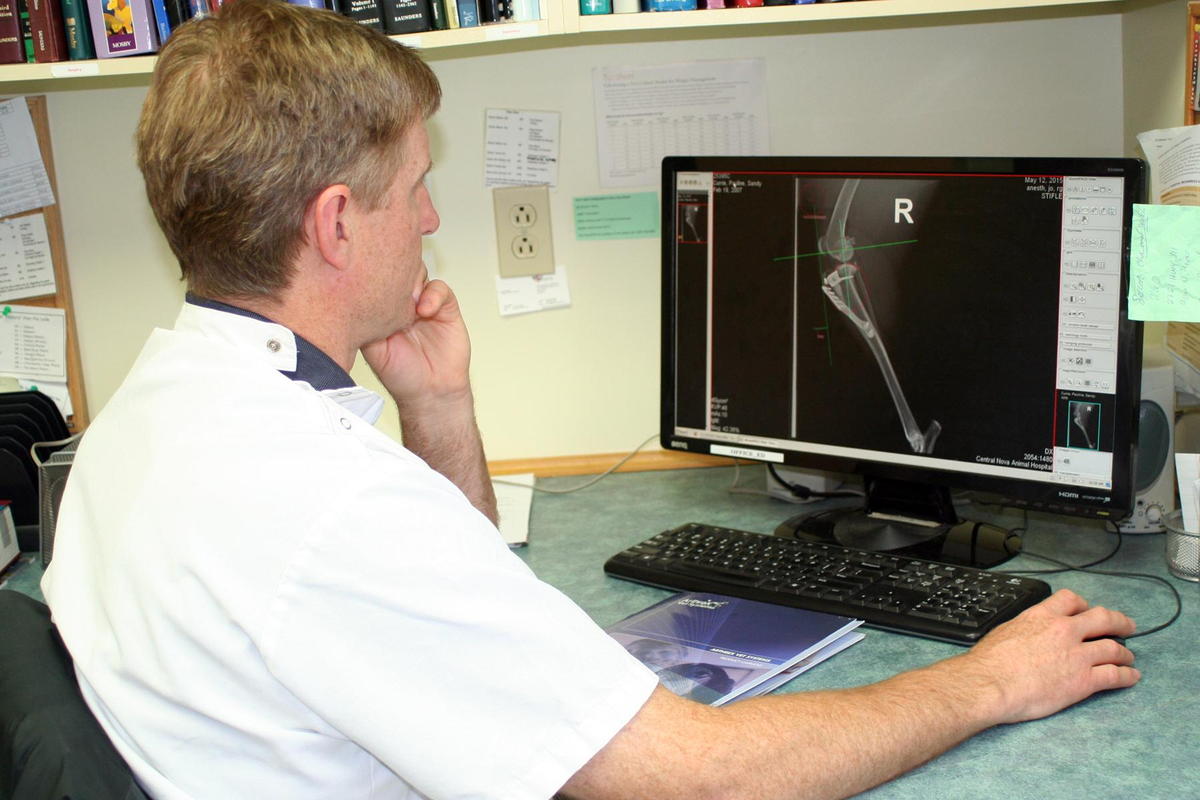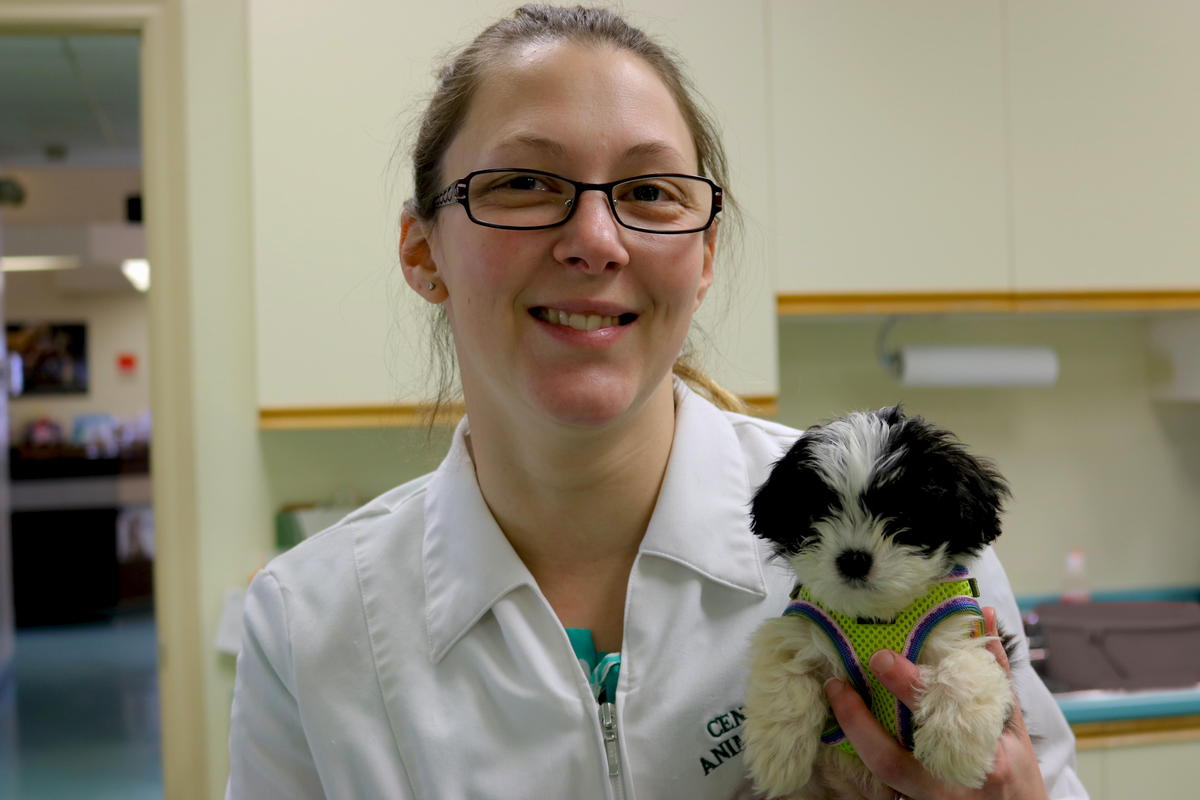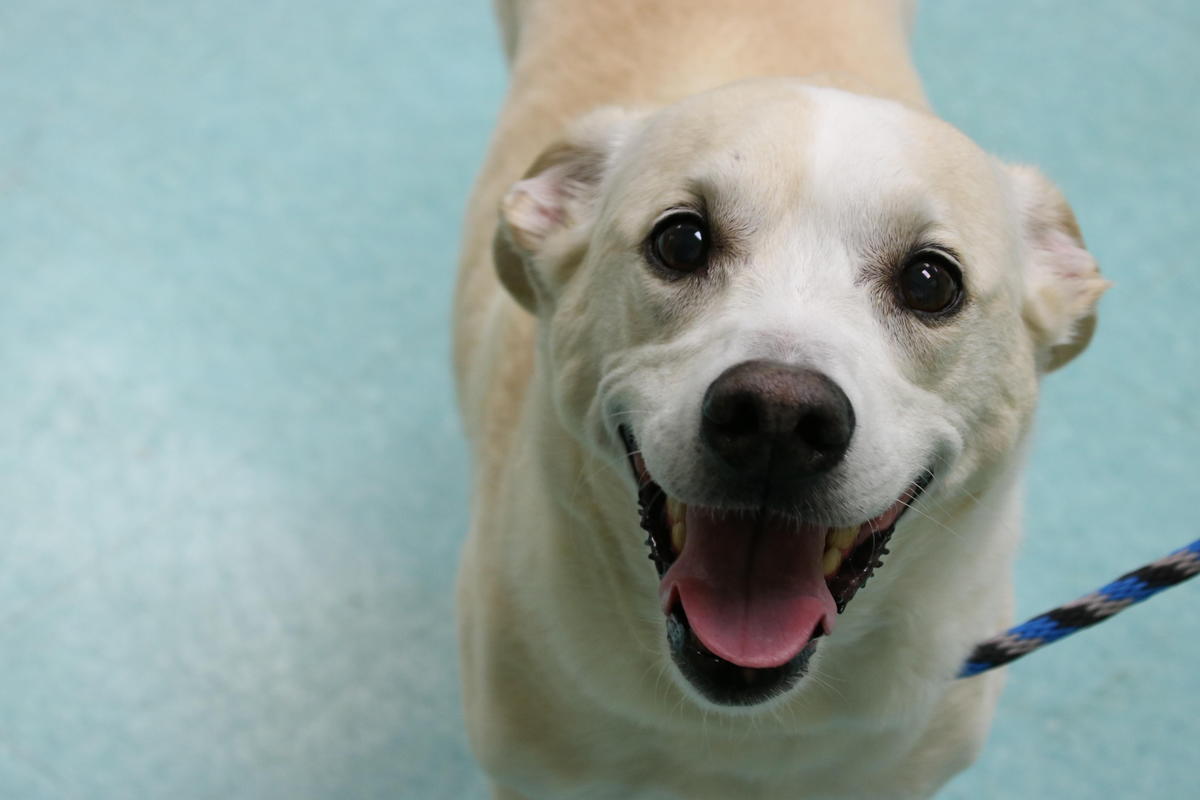At What Age Should You Spay Your Dog
posted: Jul. 09, 2019.

This is a question that we get asked a lot and we wanted to address all the different factors involved in making this decision for your pet.
Have a look at the terminology that is commonly used:
The female surgery is usually called a spay, the medical name is ovariohysterectomy. You would call a female dog that has had the procedure a spayed female. If she has not been spayed she would be called an intact female.
The male surgery is usually called a neuter or castration; the medical name is orchidectomy. You would call a male dog that has had the procedure a neutered male. If he has not been neutered he would be called an intact male.
First let's acknowledge that we know for certain from many studies that spaying and neutering is strongly associated with an increased lifespan . (In one study life expectancy of spayed females was increased by 26% over intact females, in another study the lifespan of neutered males was increased by 18% over their intact counterparts.) This increased life expectancy happens because even though spaying and neutering increases the risk of certain issues (some types of cancer and orthopedic issues), it substantially decreases the risk of death from many more causes (other types of cancer, trauma, infections, etc).
So there is no question that spaying and neutering is beneficial to the health of most pets. The question is - at what age should it be done? The answer, unfortunately, is not simple.
Traditionally here in North America pets have been spayed and neutered around the time of, or just before reaching, sexual maturity. It has been felt that this was a nice balance between letting the pet mature, but not to the point where messy heats, accidental pregnancies or some of the more obnoxious male behaviours developed. In European countries routine spaying and neutering is less common; most pets remain intact for their whole lives unless the surgery is needed to treat a medical condition. People started to notice differences in rates of some diseases between European (mostly intact) pets and North American (mostly spayed and neutered) pets. This has led people to start investigating what effect spaying and neutering has and questioning the age at which it is best to perform these surgeries.

We will take a look at each individual concern below and you will see that spaying and neutering at a younger age decreases the risk of certain problems and diseases but it can also increase the risk of others. Vice-versa for older spays and neuters, which increases the risk of some problems and disease but decreases the risk of others.
This post is going to get a little long and involved as we wanted to address all the factors involved. A brief summary with our recommendations is at the bottom for those more inclined to scroll through the technical stuff.
Let's take a look at the individual issues for which we have data:
Cancer
Cancer is a leading worry for anyone who has furry family members. There are many factors that contribute to the development of cancer: genetic predisposition, breed, age, viral infection, environment, and chronic inflammation to name a few. Spay and neuter status can also either increase or decrease the risk, depending on the type of cancer.
- Mammary gland tumours (the pet equivalent of breast cancer) are the most common cancer in female dogs and are often malignant (spread aggressively). In the US, where most pets are spayed, the rate of mammary cancer is 3.4%. In Italy, where most pets are not spayed, between 1985-2002, mammary cancer accounted for 70% off all cases of cancer and the rate of mammary cancer in Norway was 53%. It has been well established that spaying has the greatest benefit for prevention of mammary cancer if done before the first heat (risk of mammary cancer is 0.05%). The risk of mammary cancer rises with each heat: 8% if spayed after the first heat, and 26% if spayed after the second heat. So with mammary cancer spaying is protective and the earlier the better.
- Other female cancers: ovarian cancer, uterine cancer, vaginal and vulvar cancer are all rare or uncommon and are all prevented by spaying. The age of spaying likely doesn't matter a lot as long as the surgery is performed before the cancer has a chance to develop.
- Testicular cancer is common in males, accounting for 16%-27% of cancer in sexually intact males. Neutering prevents this cancer as long as the surgery is performed before the cancer develops.
- Prostate cancer is rare in dogs. Neutering has been shown to slightly increase the risk of prostate cancer but the age of neutering likely does not impact whether or not it develops. In fact, in one study, neutered dogs tended to be older when the prostate cancer was diagnosed. Risk of prostate cancer also differs among breeds.
- Lymphoma is a type of cancer that has been studied in association with spaying and neutering with a wide variety of results. One study showed more cases of lymphoma in intact males, neutered males and spayed females than in intact females. Studies in German Shepherds and Labrador Retrievers showed no increased risk of lymphoma in neutered males or spayed females. A study in Golden Retrievers showed no increased risk of lymphoma with spaying at any age, but found an increased risk in males neutered before 1 year of age.
- Mast cell tumours have a varying prognosis depending on tumour grade and location. Breed of dog plays a role in risk, regardless of spay or neuter status. There have been studies that indicate that spayed females may have a higher risk than intact females, but the age of spaying was not taken into consideration. There have been other studies done on Golden Retrievers, Labrador Retrievers and German Shepherds in which there was no difference in the risk regardless of spay/neuter status or age of spaying or neutering.
- Hemangiosarcoma is a serious cancer of dogs. Neutering of males of all breeds studied does not increase risk of this cancer, other than one study in Vizslas in which males that were neutered after 1 year of age were at increased risk. Studies in female Vizslas and Golden Retrievers showed increased risk for hemangiosarcoma when spayed after 1 year of age. Golden Retrievers spayed when more than 1 year old were 4x more likely to develop this cancer than intact females and females spayed before 6 months of age. Another, follow-up study in Golden Retrievers of both sexes showed no increased risk at all with spaying. Spaying and neutering does not cause increased risk for this type of cancer in Labrador Retrievers or German Shepherds.
- Osteosarcoma is the most common type of bone cancer in dogs. Large and giant breed dogs have increased risk of this type of cancer. One study that did not look at age of spaying and neutering found increased risk in both males and females over their intact counterparts. A study in Rottweilers showed increased risk for both sexes if they were spayed or neutered before 1 year of age. A study in German Shepherds showed no increased risk with neutering regardless of age.
Orthopedic Problems
Orthopedic diseases such as Cranial Cruciate Ligament (CCL or ACL) injuries and hip dysplasia are not inherently life threatening but they can have significant impact on quality of life and can have financial implications if surgical repair is required. Spaying and neutering may be a risk factor for these issues, but larger breed dogs are inherently at increased risk.
- Hip dysplasia : Genetics is the biggest factor in whether or not a dog develops hip dysplasia. Studies in Golden Retrievers showed a slightly increased risk in males neutered before 1 year of age and a slight increased risk for Boxers with no relation to what age they were spayed or neutered. There is no relationship between spaying and neutering and hip dysplasia in German Shepherds.
- Cranial cruciate ligament injuries are very common. These injuries have been linked with trauma, aging, obesity, the shape of the leg, the angle of the stifle joint and degeneration of the ligament. Studies have shown an increased risk of CCL injuries in spayed and neutered dogs, but the incidence varied widely among breeds. One study that looked at Golden Retrievers found an increased risk with spaying, but the age at time of spaying didn't matter. A study in German Shepherds found that those spayed and neutered before 1 year of age had an increased risk over intact males and females but did not compare for those spayed and neutered at over 1 year of age. So we are unsure if waiting to spay and neuter when dogs are a little older (i.e.: 1-2years old) would be protective or not.

Behavioural Problems
Spaying and neutering can help prevent or eliminate some behaviours including roaming, hormonal aggression, urine marking and mounting behaviour in males. In one survey of owners it was found that spaying females may increase dominance aggression, but only in those dogs that had already displayed aggression. Otherwise studies are all over the place - anxiety, noise phobias and barking were increased with spaying and neutering in some studies; separation anxiety, fearful urination and escaping were reduced with spaying and neutering in another study.
Male issues - Prostatitis and Prostatic Enlargement
Neutering males reduces the risk of prostate enlargement, prostatic cysts and infections. Neutering also reduces the risk of perianal adenoma - a type of cancer of the anal area of intact male dogs. Age doesn't matter as long as neutering is done before the disease develops.
Female issues - Pyometra, Pregnancy, Urinary Incontinence
Pyometra is a potentially life threatening infection of the uterus that is fairly common in intact females. It is prevented by spaying before it develops.
Being in heat and pregnancy comes with it's own inherent risk factors beyond having to look after and find homes for puppies. Females can have difficulty giving birth and require surgical intervention. We average 1-2 caesarian sections every month. The best time to spay to prevent pregnancy is before the first heat. If you allow your female to go through one or more heat cycles you must be very diligent. A female in heat seems to attract males from miles around! When a female dog is in heat there is typically a bloody vaginal discharge from 1-2 weeks so most owners choose to use a diaper of some type to help avoid messes.
Urinary incontinence is more common in spayed females. When this was studied it was found that spaying females between 4-6 months of age did not increase the risk for urinary incontinence compared with those females spayed after their first heat. In dogs that were older when they were spayed the incontinence developed sooner.

Obesity
Most studies show that weight gain occurs after spaying and neutering. This appears to be a result of increased appetite and changes in metabolism. Age at the time of spay or neuter does not matter. Obesity is common but is a multifactorial problem and studies have also shown that responsible management of diet and exercise can maintain appropriate body condition regardless of spaying or neutering.
Anesthesia and Surgery Complications
Spaying and neutering are elective surgical procedures and the risk of anesthetic and surgical complications must be considered along with the other risks and benefits of the procedures. Risk evaluation for a surgical candidate involves assessing age, body weight and existing medical conditions. Spaying older, larger, chubbier females is a higher risk surgery than spaying their immature counterparts. With males, neutering when they are older increases the risk of postoperative swelling and irritation and infection.
A note on pediatric spays and neuters:
This is when spaying or neutering is done at a very young age - as young as 2 or 3 months of age. These procedures are done in rescue or animal shelter situations in which the objective is to control pet over population by having all dogs and cats spayed and neutered at the time of adoption. In this scenario it is imperative that pets rehomed through these organizations do not further contribute to pet overpopulation. Once adopted out the compliance with spay/neuter contracts is only about 40%. Spaying and neutering of these animals at very young ages, before adoption, is therefore reasonable to ensure these pets are indeed spayed or neutered, to prevent unintended litters and reduce pet overpopulation. Studies have shown that these benefits outweigh any risks involved and the vast majority of these pets live happy and healthy lives.

What it all boils down to:
The risks and benefits associated with age of spaying and neutering is an area that is continuing to evolve and as new information becomes available current recommendations will be revisited and reassessed.
Small breed dogs (under 50 lbs projected adult weight): There is no question here at all, males should be neutered at 6 months of age and females should be spayed prior to their first heat (5-6 months of age).
Large breed dogs (over 50 lbs projected adult weight): This is where things become a bit trickier. In males neutering when older may reduce the risk of some types of cancer and orthopedic issues, but behavioural issues may have to be dealt with. In females spaying when older may reduce the risk of some types of cancer but increase the risk of others. Spaying when older may reduce the risk of some orthopedic issues but the spay surgery itself may be riskier and more difficult. Waiting until older may help with some behaviour but you have the issues of dealing with messy heat cycles and the possibility of unintended pregnancy.
Our recommendation, after looking at all the pros and cons, is to still favour spaying and neutering at about 6 months of age for the majority of dogs. If you ask our staff you will find that this is the age most of us spay and neuter our own pets. As with anything, there are exceptions to every rule and we encourage you to discuss all of the issues and concerns with your own veterinarian in order to make the choice that is best for you and your pet.

Sources:
Houlihan, Kendall E. A literature review on the welfare implications of gonadectomy of dogs. Journal of the AVMA2017; 250: 1155-1166. https://avmajournals.avma.org/doi/full/10.2460/javma.250.10.1155
AAHA website: https://www.aaha.org/your-pet/pet-owner-education/ask-aaha/spay-or-neuter/
PetMD website: https://www.petmd.com/dog/general-health/what-age-should-you-spay-your-dog
At What Age Should You Spay Your Dog
Source: http://centralnovavet.com/blog/126070-at-what-age-should-you-spay-or-neuter-your-pet